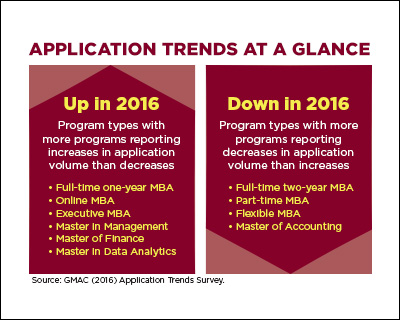Findings from the 2016 Application Trends Survey highlight a mixed market and new insights into tuition assistance.

Nearly half (49 percent) of all graduate business programs that GMAC recently surveyed received more applications in 2016 compared with 2015, according to the findings of the
2016 Application Trends Survey Report. Full-time one-year MBA, executive MBA, and online MBA programs, in addition to European programs across the board, saw more programs with year-on-year application growth than declines. At the same time, full-time two-year, part-time, and flexible MBA programs had more programs report application decreases than increases. Despite the mixed market, an overwhelming majority of programs overall (93%) report that the applicants this year are similarly or more academically qualified than those who applied last year.
This was the 17th year GMAC has conducted this annual survey—the largest and most frequently cited survey of its kind in the industry. Responses received from a record 336 business schools and faculties worldwide represent 872 graduate management programs, including MBA, non-MBA business master’s, and doctoral-level programs.

Bounce Back Year for European Programs
European business programs—which have seen stagnant volumes for several years—are experiencing an influx in applications this year. Overall, 65 percent of European-based graduate business programs (across all program types) grew their application volumes compared with 46 percent of U.S. programs and 41 percent of programs in East and Southeast Asia.
Further, European full-time one-year MBA programs stand out in this year’s findings—nearly 3 in 4 (74%) programs report year-on-year increases. In contrast, just 43 percent of U.S.-based programs and 45 percent of programs in East and Southeast Asia report volume growth in the full-time one-year MBA market.
Full-Time MBA Programs
This marks the first year since 2012 that a greater share of full-time one-year MBA programs reported year-on-year application volume growth than full-time two-year MBA programs.
- For two consecutive years, a majority of all full-time one-year MBA programs reported year-on-year application volume growth. This year, 57 percent or programs reported growth, building on the momentum of last year’s 51 percent.
- For the first time since 2012, less than half of full-time two-year MBA programs (43%) experienced year-on-year application growth. This is the second straight year that the share of programs reporting growth is down from a high of 61 percent in 2014.
Professional MBA Programs
Among professional MBA programs, executive and online MBA programs made positive strides this year, whereas part-time and flexible MBA programs took a step backwards compared with their application numbers from prior years.
- For the first time since 2008, a majority of executive MBA programs (51%) report growing volumes, eight percentage points higher than programs that reported growing volumes in 2015.
- For the second consecutive year, a majority of online MBA programs (57%) report growing application volumes, up from 50 percent of programs that reported volume growth in 2015. Survey responses also show that nine percent of online programs are new in 2017, signaling schools are implementing programs that are of high interest to prospective students.
- Part-time and flexible MBA programs continue to exhibit the same application volume patterns seen over the past seven years since the end of the Great Recession. This year, just 43 percent of part-time MBA programs and 44 percent of flexible MBA programs report application volume growth.
Non-MBA Business Master’s Programs
While Master of Finance, Master in Management, and Master of Data Analytics programs saw improved application volumes this year, Master of Accounting programs continued to struggle.
- For the second year in a row, a majority of Master of Finance programs report growing volumes. More than half of the European (65%) and U.S.-based programs (55 percent) report volume growth this year.
- One of the newest programs in the graduate management education space — Master in Data Analytics — continues to see growing demand. Nearly all (94 percent) of the 16 data analytics programs that submitted data comparing 2015 to this year report application volume growth in 2016. The survey also shows program growth in this area as six new programs will be seating their first classes this year.
- After three years of slowing growth, the Master in Management program holds steady in 2016 with a majority (51 percent) of programs reporting growing application volumes. More European programs (58 percent) report growth compared with half (50 percent) of U.S.-based programs.
New Insights on Tuition Assistance
For the first time, this year’s survey asked business schools for details surrounding the kinds and amount of tuition assistance they provide to admitted students. Across all program types—and by a large margin—the most common form of tuition assistance offered to candidates is merit scholarships. The majority of programs offer such financial aid, including 78 percent of full-time MBA programs. In total, about 1 in 4 candidates entering full-time MBA programs (27%) will receive merit scholarships this year.
For more of findings about graduate business school application volumes, applicant pool composition, targeted candidate outreach, tuition assistance, and employer funding, download the 2016 Application Trends Survey Report. For specific findings on the Canada, India, and Africa markets, go to the Research Insights web page at gmac.com/researchinsights.